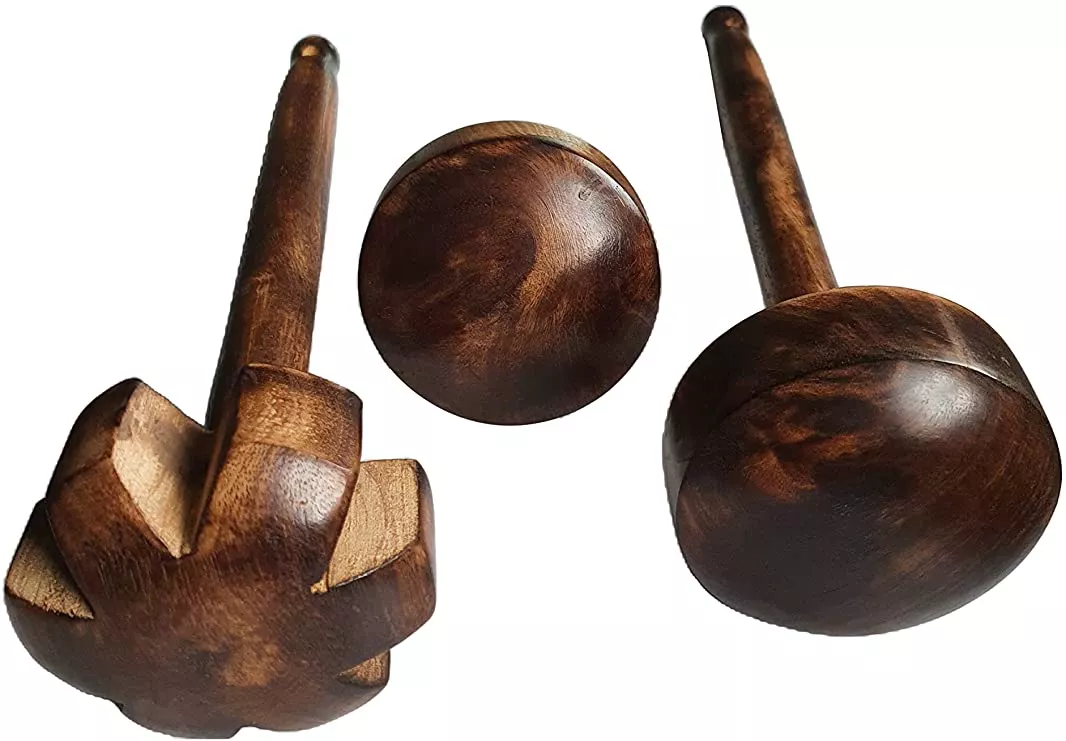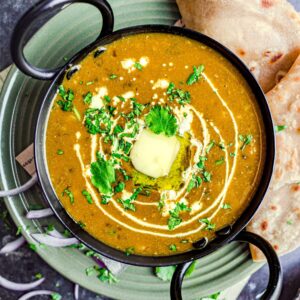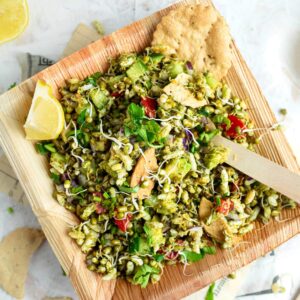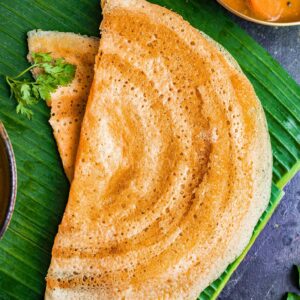Dal Bhaji, Maharashtrian Lentil and Spinach Curry
Thick and creamy lentils spiced with warming seasonings, fresh spinach, and nutrient-loaded peanuts: Dal bhaji is a hidden gem from the Vidarbha region of Maharashtra, where it has pride of place on every table as a wholesome and hearty vegan main.
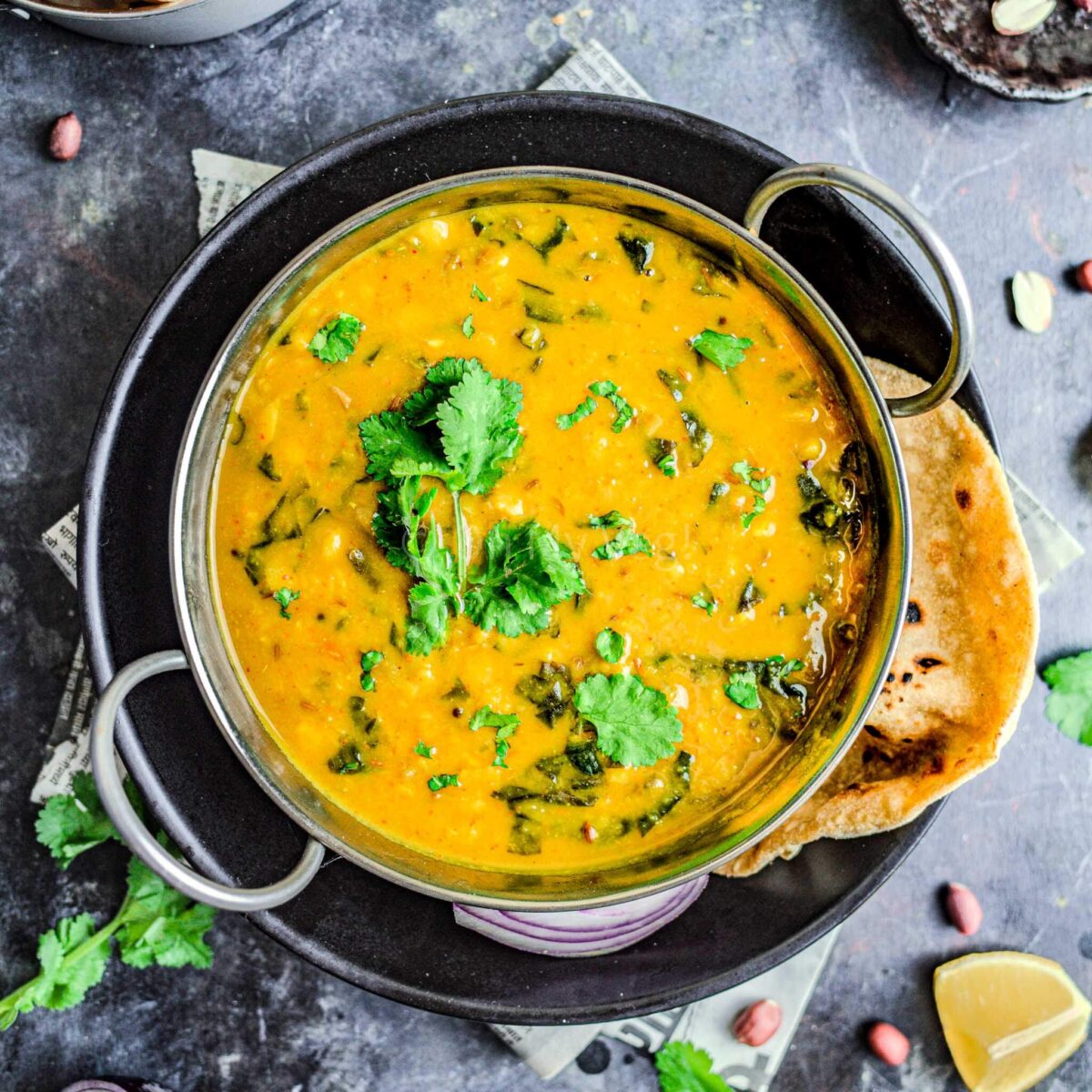
You won’t find this dish in cookbooks. Forget being served a dish of this steaming hot dal bhaji at a restaurant. In fact, it’s almost impossible to find the recipe online.
That’s not because the dish isn’t worthy of the acclaim. Quite the opposite, in truth.
Dal bhaji is a real “hidden gem” of culinary India — a dish you’d only discover if you were lucky enough to stay with a local family, sampling their authentic, traditional fare.
Unfortunately, most of us will never have that opportunity. But, luckily for you, I do have the recipe, so you can recreate the flavours of rural Vidarbha at home.
I was taught this dish by a family who have lived in the villages of Vidarbha for multiple generations. Without pause, they serve dal bhaji every week — and no wonder, as it’s a real powerhouse of nutrition, especially since it’s naturally gluten free and vegan too.
I’ve meant to share this special recipe on Oh My Veg for years, and now, it’s finally here. I hope you’ll all love it as much as I do!
❓What is Dal Bhaji?
Across India, the name “dal bhaji” is applied to several different dishes.
However, our recipe starts with a creamy base of cooked toor dal (also known as pigeon peas or arhar dal, read my guide to pulses to learn more) which is then mixed into a flavoursome tempering of spices, garlic, whole peanuts, and plenty of chopped spinach.
These simple foundations reflect the dish’s meaning in Marathi, which translates to lentils (dal) with vegetables (bhaji).
Dal bhaji is similar to a North Indian dish called dal palak, although there are crucial deviations.
Besides, while spinach is the most popular leafy green for this recipe, dal bhaji is adaptable. But, more on that later!
🇮🇳 Where is Dal Bhaji From?
Dal bhaji is a dish originating in Maharashtra, a large state in central-western India.
According to the family who taught me this recipe, it’s unique to the Vidarbha region (which encompasses the Amravati and Nagpur divisions).
I’ve spoken to many Marathi people from other areas, including Kolhapur, Pune, and Mumbai — yet none of them knew of dal bhaji. This seems to confirm it’s a regional speciality!
For that reason, you’ll often see dal bhaji referred to as “Vidarbha special dal bhaji” or “Varhadi special dal bhaji.”
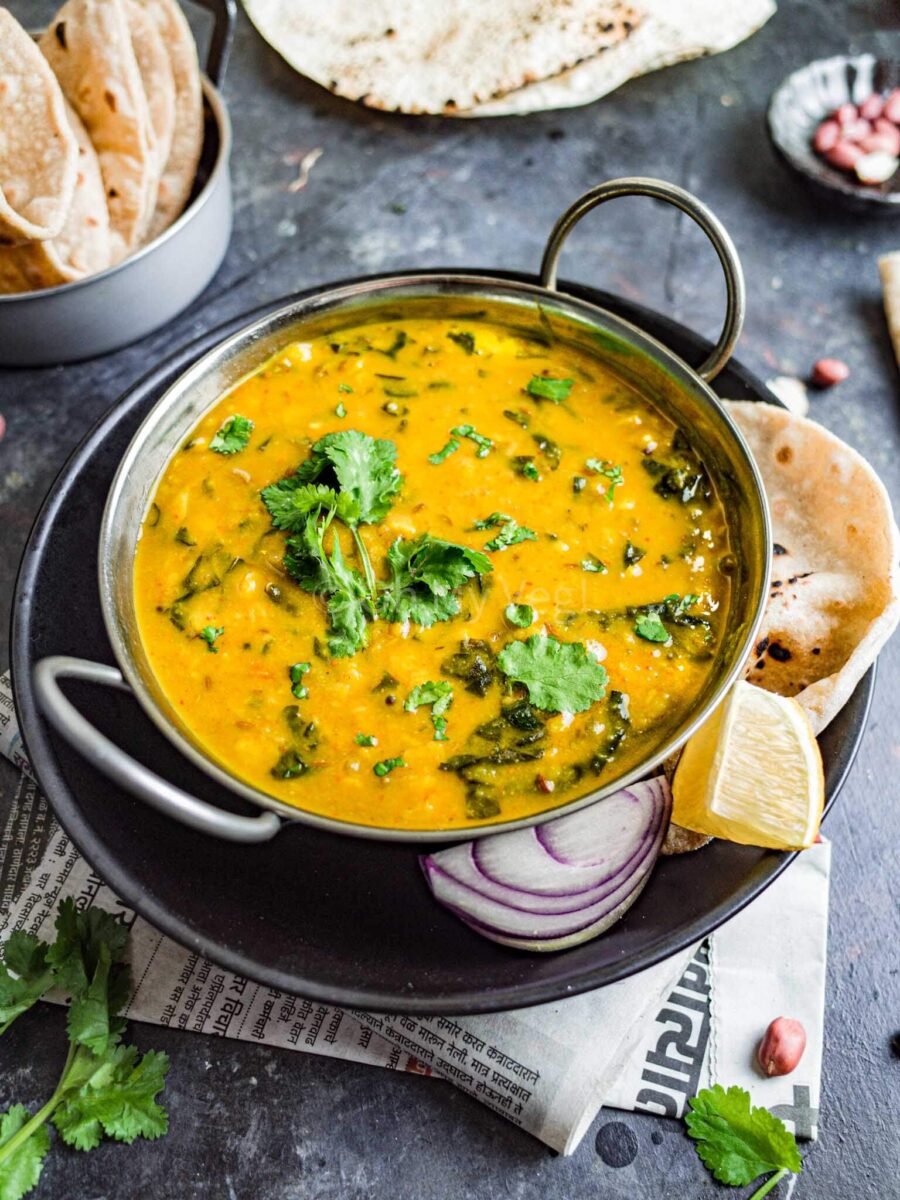
🍃 Ingredients You’ll Need for Dal Bhaji
Recipes from the Vidarbha region are renowned for their basic spicing that somehow still manages to hit you with full-on flavour. Dal bhaji is no different.
Most spices here are pantry staples if you regularly cook Indian food. Others may require a trip to the Asian market — such as goda masala, jaggery, or toor dal. Hint: If you don’t have one locally, you can likely find everything you need online!
- Lentils are the backbone of dal bhaji. Traditionally, toor dal aka arhar dal or pigeon peas are used — they have a nutty and mild flavour, with a creamy consistency.
Important: Don’t mistake toor dal for the confusingly named “yellow split lentils.” They aren’t interchangeable. Read more in my guide to beans, lentils, and pulses! However, while chana dal boasts a different taste, it can be substituted if needed. - Oil is a flavour carrier that allows us to bloom and temper the spices, bringing out the best of the ingredients. Use neutral oil — groundnut oil is the most traditional.
- Whole spices such as mustard seeds and cumin seeds provide pops of pungency.
- Dried spices including turmeric, coriander, and red chilli powder are essential to build the layers of characteristic depth. You’ll also need goda masala, a sweet-smelling, smoky regional blend we’ll use as a finishing spice.
- Aromatics like onion and garlic melt down into the lentils, giving us natural sweetness. I also add green chillies (jwala) for fruity heat to contrast the more sharp fire of red chilli powder.
- Tomato adds umami and sourness, balancing out the dal bhaji.
- Raw peanuts bring earthy flavour and add a bite to the texture. They’re also packed with plant protein! Use pink or red-skinned peanuts.
- Spinach is fresh and slightly sweet in flavour. It provides essential nutrition like iron.
- Jaggery balances the sourness with a hint of caramel-like sweetness. It’s optional!
- Lemon juice cuts through the spice to add a pop of sharp citrusy acidity.
🥜 Variations and Substitutions
As I mentioned previously, dal bhaji is an exceptionally adaptable and versatile dish.
Now, I like the recipe best as I’ve written it (surprise surprise!). But, there is room for artistic experimentation here.
For example, instead of using lemon juice as our souring agent, you could use tamarind or even kokum.
And rather than using spinach, you can opt for any other mild and slightly bitter leafy green like red amaranth (lal math) or methi.
While coconut is less frequently used in eastern Maharashtrian cooking like Vidarbha, you can also add roasted and dried coconut to add a touch of sweetness. Yum!
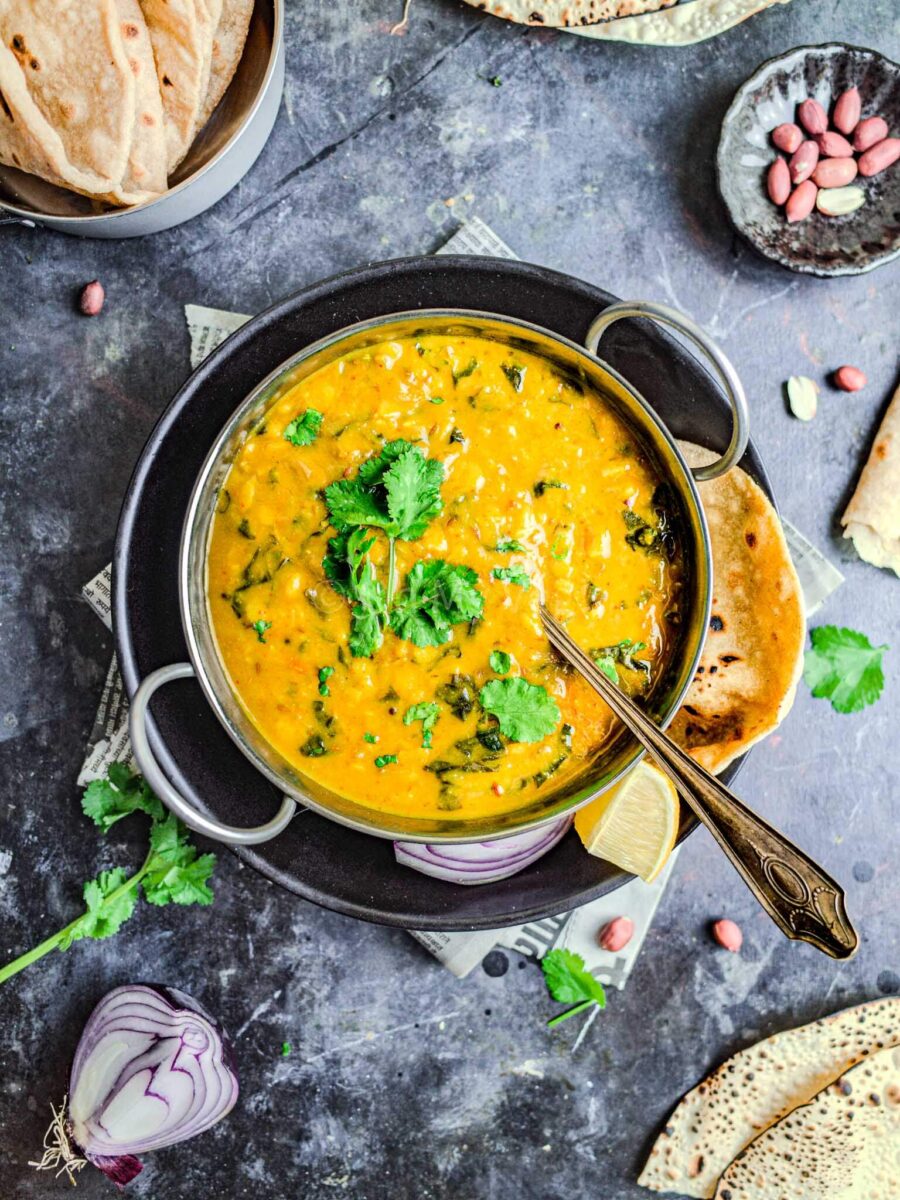
🧑🍳 How to Make Dal Bhaji
You don’t need any cooking know-how to make dal bhaji — especially not with my straightforward step-by-step instructions.
At its core, it’s just a variant of dal fry (except with way more plant-powered protein!): thick and creamy cooked lentils stirred into a tantalizing mix of spices, nuts, and leafy greens.
The full recipe can be found further down the page, but here’s an overview.
- Pressure cook the dal for 4 whistles.
- Meanwhile, temper the mixture by heating oil in a large kadai, then cooking the mustard and cumin seeds until they crackle. Add the green chillies, chopped onion, crushed garlic cloves, and whole raw peanuts, cooking until the aromatics have softened.
- Next, add the tomatoes. Cook until broken down, then add the chopped spinach and cook until wilted.
- Build depth with the ground spices: turmeric, coriander, and red chilli powder. Stir in to mix.
- Add the cooked dal to the pan and using a ghotni (dal whisk), whisk the dal until smooth.
- Adjust the consistency with water and season with salt and jaggery.
- Let the dal bhaji simmer for around 10 minutes, then sprinkle with goda masala and add lemon juice. Serve hot.
As you can see, making dal bhaji isn’t hard — but you will require some essentials of Indian cookware. Namely a pressure cooker, kadai, and dal ravi/ghotni.
Having these items on hand will make your cooking experience stress-free. While I’ve made Indian food without the appropriate gadgets, comparatively, it’s a painful process.
Here are my recommendations:
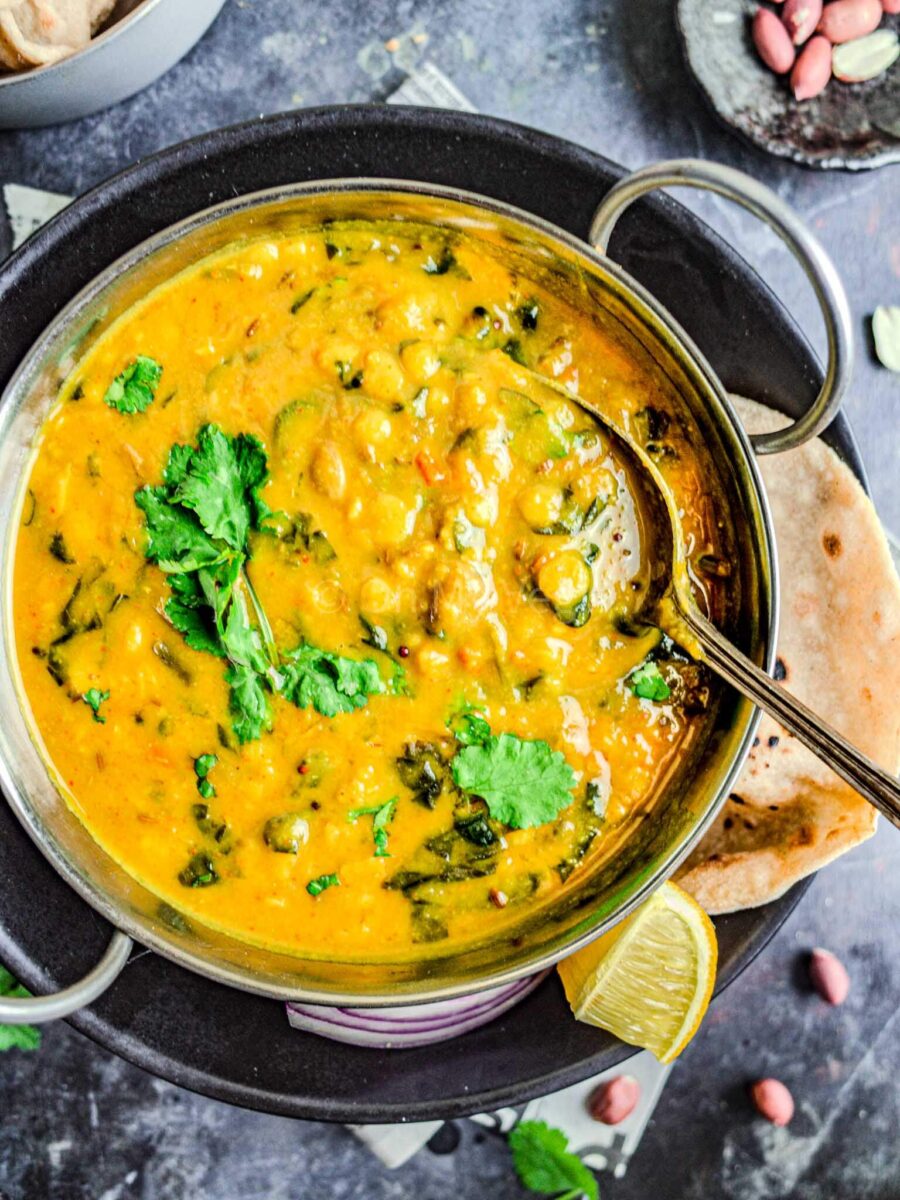
🫓 What to Serve with Dal Bhaji
Since dal bhaji is more of a rustic homely dish than a restaurant-style affair, I like to keep things unpretentious. Raw onion is a must (traditionally, it’s smashed; but cutting off a wedge is fine), as is extra lemon for people to squeeze onto the food to taste.
Chapati (poli, in Marathi) or jwarichi bhakri (sorghum roti) are my bread of choice. I then like to serve simple steamed rice or jeera fry rice for second portions (yes, you must have a second portion!).
Up the healthy factor by serving methi gholana or the iconic kachumber salad on the side. It’s no effort, too! Even cut and salted cucumber aids in cooling down the spice.
Finally, contrast the smooth texture of the dal with crispy fried or roasted papad on the side.
💌 Why You’ll Love This Recipe
If you tried this dal bhaji recipe — or any other recipe on my website — please leave a 🌟 star rating and let me know your thoughts in the ✍️comments at the bottom of the page. Thanks for being a part of my community!
Dal Bhaji, Maharashtrian Lentil and Spinach Curry
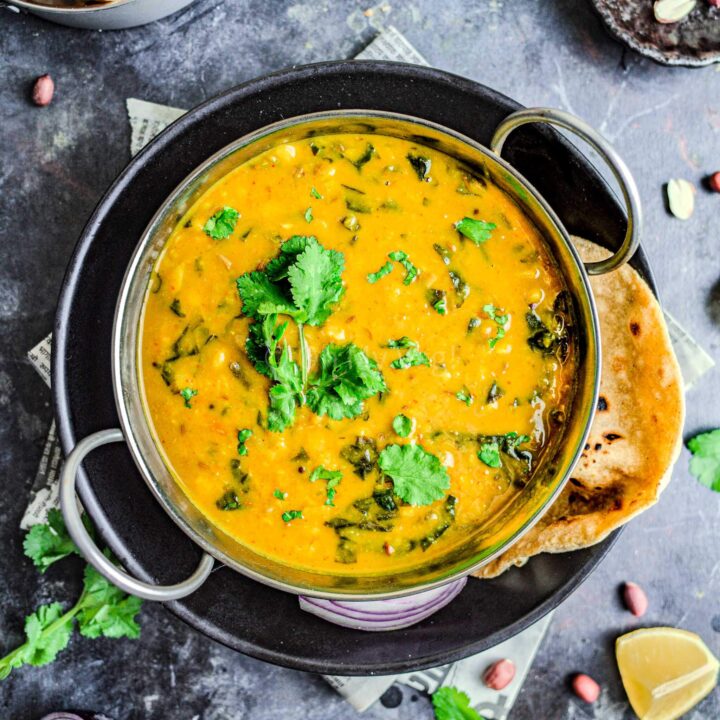
Vidarbha special dal bhaji is made from creamy lentils, fresh spinach, raw peanuts, and a delicious mix of garlicky spices. It's vegan and GF.
Ingredients
To Cook the Dal
- 120g Plain Toor Dal (Arhar Dal, Tuvar Dal)
- 300ml in the pressure cooker*
To Cook the Dal Bhaji
- 3 tbsp Neutral Oil
- 1/2 tsp Mustard Seeds
- 1 tsp Cumin Seeds
- 2 Green Finger Chillis, finely chopped
- 40g Red Onion, finely chopped
- 6 Garlic Cloves, roughly crushed / chopped
- 40g Pink Peanuts
- 40g Tomato
- 60g Spinach (Large Handful), roughly chopped
- 1.5 tsp Red Chilli Powder
- 1 tsp Coriander Powder
- 1/2 tsp Turmeric Powder
- 1 tsp Salt, or to taste
- 300ml Water, to further cook Dal
- 1/2 tsp Jaggery, optional
- 1 tbsp Lemon Juice
- 1/4 tsp Goda Masala
Instructions
- Wash the dal and drain. This is important to ensure there are no small stones.
- Pressure cook the dal*. Add the toor dal along with 300ml water to a pressure cooker. Set over medium heat and cook for 4 whistles. While the lentils cook, move on to the next tasks.
- Make the dal bhaji. In a large kadai, heat neutral oil over medium heat. Once hot, add the mustard seeds. When they pop, add the cumin seeds and cook until they crackle. Next, add the green chillies, chopped onion, crushed garlic cloves, and whole raw peanuts. Cook, stirring now and then, until the mixture smells aromatic and the onions have softened.
- Next, add the tomatoes. Stir into the mixture and cook until soft and mushy. Then add the washed and chopped spinach, cooking until wilted.
- Add the ground spices: red chilli, coriander, and turmeric powder. Stir the mixture well.
- Now add the cooked lentils. They should be soft and mushy. Immediately use a ghotni (dal ravi/dal whisk)** to beat the dal until it achieves a smooth, creamy texture.
- Adjust the consistency of the dal bhaji with around 300ml water. Also, season with salt to taste, and optionally, jaggery.
- Let the dal bhaji simmer for around 10 additional minutes, or until it reaches the desired consistency. Sprinkle with goda masala as a finishing touch, squeeze in some fresh lemon juice, and serve hot.
Notes
* Pressure cooking the lentils is the most time-effective way to cook toor dal. My preferred method involves cooking the lentils and rice (to serve) simultaneously using small pots which fit inside the pressure cooker.
Don't have a pressure cooker? No worries. Toor dal takes considerable time to cook without pressure, but it's doable. Use 700ml water (as opposed to 300ml) and cook low and slow for around 45 minutes to an hour.
** To use a ghotni, place the wooden stick between your two palms, then move your palms forwards and backwards, in opposite directions, to rotate the whisk. This works by simultaneously breaking down the dal and whisking it.
While you can use a standard metal whisk in lieu of a proper ghotni, it doesn't do quite the same job. For dal bhaji, we want a thick, smooth texture.
Recommended Products
As an Amazon Associate and member of other affiliate programs, I earn from qualifying purchases.
Nutrition Information:
Yield:
4Serving Size:
1Amount Per Serving: Calories: 548Total Fat: 35gSaturated Fat: 7gTrans Fat: 0gUnsaturated Fat: 22gCholesterol: 50mgSodium: 1824mgCarbohydrates: 35gFiber: 8gSugar: 6gProtein: 27g
Nutrition information isn’t always accurate.






